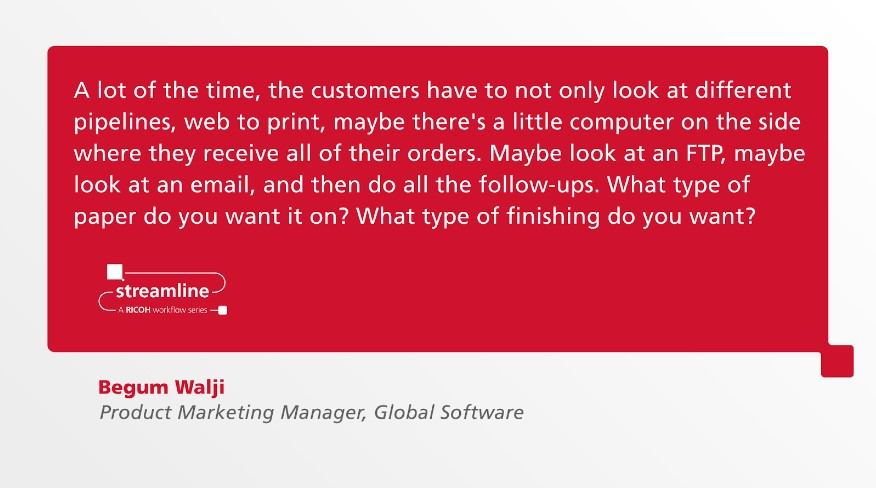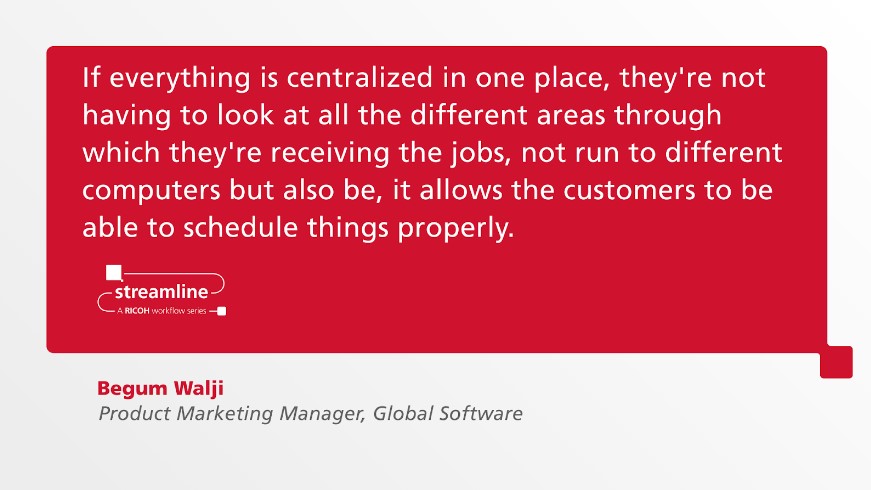The Multi-Channel Job Onboarding Struggle
Print businesses lose countless hours and potential revenue every year to inefficient job onboarding processes. The culprit? Disparate systems and manual workflows. In today’s competitive print landscape, efficiency is no longer a luxury – it’s a matter of survival. Yet, many print businesses find themselves bogged down by a common bottleneck: inefficient job onboarding.
This reliance on a patchwork of systems creates a logistical nightmare for print businesses, leading to lost time, increased errors, and ultimately, a hit to the bottom line. As Begum aptly described, navigating the modern print landscape often feels like managing “multiple pipelines.” Let’s break down the common culprits behind this multi-channel struggle and how they impact print businesses.

Email: A Sea of Attachments and Missing Information
Email remains a primary communication channel, but it’s ill-equipped to handle the complexities of print job submissions. Attachments get lost in overflowing inboxes, vital job specifications are omitted, and version control becomes a nightmare. This often leads to time-consuming follow-ups, just to gather basic information before production can even begin. As Begum notes, “Thirty percent of the jobs coming in [are] via email with follow-ups required.”
FTP: Cumbersome Transfers and Security Concerns
While FTP sites offer a dedicated space for file sharing, they’re often plagued by limitations. Large file sizes become problematic, requiring alternative solutions like public shared drives, which introduce security vulnerabilities. Navigating clunky interfaces and managing user permissions adds another layer of complexity.
Web-to-Print: High Expectations, Frequent Inconsistencies
Web-to-print portals hold the promise of streamlined ordering, but they don’t always deliver. Inconsistencies across platforms, limited customization options, and integration challenges with existing systems can lead to frustration for both print providers and their clients. Begum underscores this, stating, “If a customer has a web-to-print tool, a lot of the times there is [still] always some sort of a follow-up required.”
The Price of Disconnected Workflows: Time, Money, and Client Trust
The consequences of juggling these disparate systems are significant. Precious time is wasted on manual processes, back-and-forth communication, and searching for misplaced files. The increased risk of errors leads to costly reprints and rework. Ultimately, these inefficiencies can damage client relationships, impacting your reputation and future business.
The key to overcoming the challenges of multi-channel job onboarding is surprisingly simple: centralization. By implementing a single platform to receive, manage, and track print jobs—regardless of their origin—businesses can transform their operations and regain control. Imagine a world where you no longer have to jump between email inboxes, FTP clients, and web-to-print portals.
Centralized job onboarding software acts as a single source of truth, aggregating all job details in one easily accessible location. This eliminates the risk of information falling through the cracks, ensures everyone is working from the same page, and drastically reduces the potential for errors.
The benefits of this unified approach are far-reaching. With a centralized system, clear communication and reduced manual intervention minimize the risk of costly mistakes. This results in higher-quality output and, most importantly, happier customers. Additionally, less time is wasted on administrative tasks and troubleshooting, leading to faster turnaround times.
Print shops can then process jobs more efficiently, increasing output, and maximizing revenue potential. And it doesn’t stop there; a centralized system naturally paves the way for data-driven decision-making. The platform becomes a goldmine of information, allowing businesses to track key performance indicators, identify bottlenecks, and make data-backed decisions to optimize their workflows continually.
By bringing order to the chaos of multi-channel job onboarding, print businesses can unlock a new level of efficiency, profitability, and customer satisfaction.

Centralization provides the essential foundation, but to truly maximize efficiency, print businesses need to embrace the power of automation. As Begum advises, “The new breed that’s coming in is expecting automation because some of the traditional things that we had to do to open up a file, add a bleed, maybe they don’t have the skill set.”
A well-designed job onboarding platform enables the seamless integration of automation features, further streamlining processes and minimizing the potential for human error.
Automation in Action: Eliminating Manual Tasks and Boosting Productivity
One of the most valuable automation features is automated preflighting. Imagine pre-configured checks running automatically on every incoming job, verifying file format, resolution, bleed, color space, and other crucial elements. This ensures that only print-ready files move forward in the workflow, eliminating time-consuming manual checks and preventing costly errors downstream.
File conversion and optimization can also be automated, saving countless hours of manual adjustment. The platform can intelligently convert files to the required formats, optimize image resolution for printing, and even perform basic file repairs, all without human intervention.
Intelligent job routing takes automation a step further. Rules-based logic can be implemented to direct incoming jobs to the appropriate equipment or production queue based on factors like job type, quantity, paper size, and finishing requirements. This eliminates manual decision-making, balances workload across devices, and ensures that jobs are processed in the most efficient way possible.
Implementing a centralized, automated job onboarding system is a significant step toward operational excellence for any print business Begum shares. But with so many solutions available, choosing the right platform for your specific needs is crucial.
Essential Factors to Consider:
Ease of Use: The platform should be intuitive and user-friendly, with a clear interface that requires minimal training for your team to master. A complex system can lead to frustration and hinder adoption, negating the efficiency gains you’re aiming for.
Scalability and Flexibility: As your business grows and evolves, your job onboarding solution should be able to scale alongside you. Look for a platform that offers flexible configuration options, customizable workflows, and the ability to integrate with new equipment or software as your needs change.
Integration Capabilities: Seamless integration with your existing Management Information System (MIS), prepress software, and other critical tools is essential for maximizing efficiency and avoiding data silos. Ensure the platform you choose offers robust APIs or built-in connectors to seamlessly connect with your current technology ecosystem.
As Begum Walji shared, the print industry is evolving, and automation is key to meeting the challenges of today’s production environment. A streamlined, automated job onboarding process is no longer a luxury for SMBs — it’s a necessity to remain competitive, efficient, and profitable.
Don’t let outdated workflows hold your print business back. Embrace the future of print onboarding and explore the possibilities of a centralized, automated solution. Discover how it can transform your operations, leading to increased profitability, greater client satisfaction, and a brighter future for your business.
Ready to learn more? Visit the Ricoh website to explore our innovative systems designed to optimize print workflows and empower businesses like yours to thrive.
Back to All Blogs
Contact Us
Contact form on the bottom of all pages
